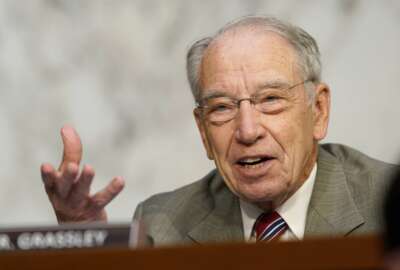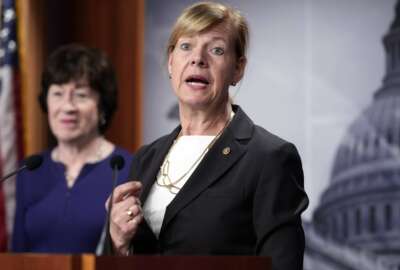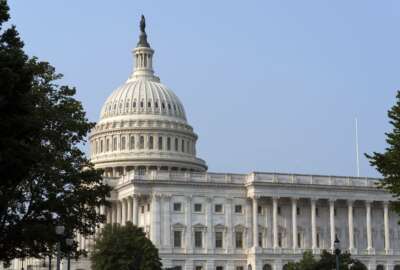Hubbard Radio Washington DC, LLC. All rights reserved. This website is not intended for users located within the European Economic Area.
On Air: Federal News Network
Trending:
Recipe for a successful DATA Act is part collaboration, part oversight
OMB and Treasury are creating a roadmap on how to move forward with DATA Act implementation over the next 12 to 36 months. Meanwhile, congressional and executiv...
The Digital Accountability and Transparency Act (DATA Act) has already garnered more attention, more high-level focus, in four months since it became law than previous federal transparency laws did in the last seven years.
The big question is: Will that focus and attention last beyond this first year?
Some experts in the federal community say the DATA Act is different than other transparency laws, such as the Federal Financial Accountability and Transparency Act (FFATA), for many reasons.
Congressional staff members and agency inspectors general say because of the way oversight is built into the law, implementation will be watched closely from the beginning and throughout the next seven years. It is a lesson learned from the success of the Recovery Act, and something FFATA never had.
In fact, the Treasury Department IG already has two ongoing audits around data transparency. Bob Taylor, deputy assistant IG at Treasury, said one audit is looking at how Treasury set up its transparency office. The second focuses on how the Office of Management and Budget and Treasury are working together on implementing the DATA Act.
Taylor said his office’s role expands as more work is done to implement the DATA Act.
Section 6 of the DATA Act, aptly named “Accountability for Federal Funding,” calls for IGs to conduct reviews and report to Congress three times over the next six years. Their reviews will cover their respective agency’s spending data and the use by the agencies of the data standards that will be introduced by Treasury and OMB, Taylor said Tuesday at the Data Transparency 2014 event in Washington, sponsored by the Data Transparency Coalition. Under the Act, the three reviews are to be done in consultation with GAO and are to include a statistically valid sampling of spending data submitted to USASpending.gov. The IGs are to specifically assess the completeness, timeliness, quality and accuracy of the sampled data.
The Government Accountability Office also will review similar implementation actions.
Taylor said the IGs will report first in November 2016, roughly 18 months after OMB and Treasury issue the data standards in May 2015. Then, the IGs will report to Congress every two years through 2020. GAO will report in 2017, and then every two years through 2021.
Taylor said there is one additional challenge for the IG’s reporting — agencies are to start submitting data that meets the new standards as late as May 2017. The first IG report is due in November 2016, six months before.
Congressional oversight already has begun
Another reason for the long legs of the DATA Act is Congress, itself. Experts say more and more members understand the value of data, the value of technology and why making federal data more accessible, usable and overall transparent matters.
Amy Edwards, a staff member of the Senate Budget Committee, whose member, Sen. Mark Warner (D-Va.), was an author of the DATA Act, said the committee already knows some of its oversight priorities.
“I think linking the data streams from the budget, accounting, procurement and grant universe is an important number one priority because it’s the foundation for what we hope the DATA Act success will be,” she said. “So that’s something we are monitoring closely, getting quarterly, if not more, updates from the teams, the interagency working groups and from OMB and Treasury. We are monitoring that work, which is due out in a year from the law was enacted, so May 2015. We will be looking to see those results and watching it closely.”
Edwards said another priority is ensuring agencies meet the requirements for the full disclosure of federal funds through USASpending.gov and the portal’s improvements.
“The other important component, and maybe one of the most important components, in addition to taxpayer transparency and access to data for decision makers, is really agencies using this information internally to guide agency operations and find savings and efficiencies,” Edwards said.
On the House side, Ali Ahmad, a staff member for the Oversight and Government Reform Committee, said OMB and Treasury need to consider four key questions:
- Who will use the data?
- What would be the best way to connect outlays to the program activity?
- How should OMB and Treasury consider the impact of proprietary identification standards? Ahmad joined a rising chorus of good government groups calling for the government to stop using unique identifiers developed only by Dun and Bradstreet. The good government groups are calling for open non-proprietary unique identification standards.
- How will OMB and Treasury visualize and contextualize the data so it can be best used by all stakeholders?
All of this oversight can’t begin until OMB and Treasury really get implementation going.
Just four months after the bill became law, there has been a lot of activity across the government.
For example, just Sept. 26, Treasury published in the Federal Register a request for information on what the best data exchange standards are within federal agencies and with the public.
Treasury and OMB also are creating an implementation roadmap on how to move forward with DATA Act implementation over the next 12 to 36 months.
The journey only has just begun
Dave Mader, the controller of OMB, said the DATA Act is a journey and not a flip-of-the-switch approach.
“This will be a very iterative approach and we will rely on lessons learned, and we also will look at opportunities to experiment because we don’t want to do, nor does anyone have the resources to build the world’s biggest database,” he said. “We believe that technology and data, and data analytics will allow us to create a very innovative approach for how to implement the next iteration of spending that’s transparent to taxpayers.”
Mader said OMB and Treasury created a steering committee, and their teams meet about the DATA Act on a daily basis.
“We’ve also created an advisory committee. One of the speakers mentioned the need to integrate the work that has been done over the years, whether it was in the grants community or the acquisition community or in the CFO Council, how do you bring all of these stakeholders, and how do you bring all of these disparate data sources together?” he said. “That is really the key to the implementation of the DATA Act.”
Dave Lebryk, Treasury’s fiscal assistant secretary, is Mader’s partner in this effort. He said there are a few underlying principles of Treasury and OMB’s implementation plans.
“This really has to be a data-centric effort. Agencies need to own the data and use the data,” Lebryk said. “It can’t be a systems effort. That’s how in the past we often approached these kinds of things in government to build a large system. There are ways to do this that are more efficient and ultimately more effective in our ability to get at data.”
Lebryk said in taking a data-centric approach, data exchange standards are critical. He said Treasury and OMB also need to work on how to best map and extract data from organizations.
“The notion about incremental and that is as we move along, not every agency will be in the same place,” Lebryk said. “So there are some who are further along than others, so we need to make sure we are making measured progress as we are going through implementation, and making data available as it is available the best that we can. It has to be reusable and we have to make sure we make maximum usage of existing investments and existing processes.”
Lebryk said the other guiding principles include collaboration with all the stakeholders, including Congress, state and local governments, good government groups, auditors and others.
Finally, he said implementation has to be agile where Treasury and OMB will use small-scale pilots to see what’s the best way to proceed in the longer term. Lebryk said there will be failures, and that’s okay, as long as they are learning.
Both Mader and Lebryk said agencies, Congress, auditors, the entire open data community need to be patient in how the DATA Act is implemented. Congress gave the executive branch three years for a reason, as this will be difficult. As Lebryk said, if it was easy, it would have been done before.
RELATED STORIES:
Treasury’s fixes to USASpending.gov begin with mapping, navigation
Agencies setting off into the next data frontier — procurement
Copyright © 2024 Federal News Network. All rights reserved. This website is not intended for users located within the European Economic Area.
Jason Miller
Jason Miller is executive editor of Federal News Network and directs news coverage on the people, policy and programs of the federal government.
Follow @jmillerWFED





